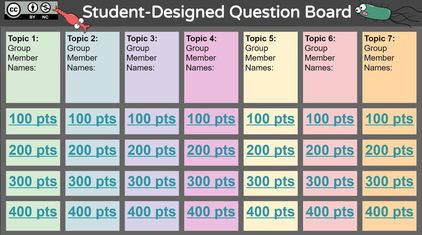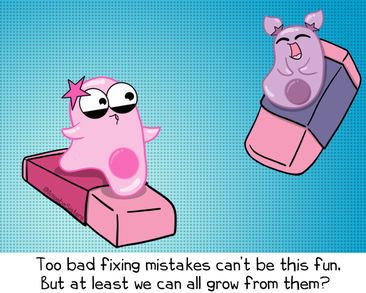|
[Additional text added March 2019] We have a lot of gratitude for YouTube. As edu creators, it allows us to publish our video content and reach others. It allows us to build a community. And it allows others to contribute subtitles in different languages. There are some challenges we face as edu YouTubers though. EDITING. Sometimes, after we publish a video, we receive helpful feedback that a clarification- or even an error- needs to be addressed. We are really grateful for this kind of feedback, because it helps us grow as educators. We make mistakes, but we have worked hard to cultivate our growth mindset so that we can learn from those mistakes and get even better! And we want to model that for high school kids too, because we think that is an important life skill. Which, is why, fixing our mistakes is very important. The only problem is that YouTube has limited ability to edit videos, and in 2016, they removed the ability to make new annotations (much to the dismay of many edu YouTubers). Also, on 1/15/2019, all existing annotations will be permanently deleted. The "cards" feature which was designed to replace the "annotations" feature unfortunately doesn't have the ability to make clarifications or address issues. So how do we handle this?
Most of the time, we are addressing a clarification or smaller scale mistake. It might be a typo. It may relate to the way we used a vocabulary word. It could be a single incorrect statement in the audio or the way we pronounced a vocabulary word. It may be related to an exception---science has a lot of exceptions! We consider something a clarification or smaller scale mistake if it does not affect the full video, but may affect a statement or component of the video that should be addressed. So how do we handle those clarifications or mistakes? You will find it as a pinned comment! That means, it will show as the very first comment underneath the YouTube video. That allows it be front and center, and it is a popular method that many edu creators use to address those clarifications or mistakes. We remake videos every once in a while as our art and scripts improve. When we remake a video, we check the pinned comment of the old video to make sure to address those clarifications or mistakes from the past. And, don't worry, unless there is a major issue with an old video---we do not delete old videos. We want people to know how we have improved with lots and lot of practice! [Added March 2019: YouTube now allows small clip-outs of video portions even on videos with high view counts. We have used this feature on a few older videos, and it's explained on the pinned comment for the video] If you are an educator, we highly recommend checking out the "pinned" comment on our videos! Please also share this with students, because we want students to see that we do make mistakes. We want students to see how we handle mistakes, and we want students to feel empowered to keep going when they make mistakes too. Unfortunately, if it's a major error that affects the main concept of the video, we remove the video and re-publish the video. It has been extremely rare, and it's definitely frustrating to do as a creator, because the link to the video is destroyed when you remove a video. We take a lot of effort to try to avoid this by double checking our facts before releasing a video. You can see our factual references in our expanded video details. If there is no issue with a video (that we have been made aware of), we often pin supplemental information or links in our pinned comment. As always, we thank our viewers for helping us grow as edu creators! :) Education is changing, and the way that we reach our students may need some transformation. When we were kids, the way we did our research consisted of going to the school library to read through the alphabetized encyclopedias. Now everything is often just a "Google" away. You can learn how to change a tire or master a video game on YouTube. There are a lot of ways to consume information now; it makes sense that we're all looking for ways to transform learning for our kids to use the information to create, solve problems, and ask their own questions.
But the absolute statements in education---those generalized statements that tend to classify everything in one category ---make us wary. They are not the answer. Absolute statements tend to be used to attack all lectures, all textbooks, all worksheets, etc. These statements tend to get a lot of attention; some come with their own Twitter hashtag and maybe even a book. The trouble with these statements is that they tend to classify everything in the category it attacks as the same. "You should never use lectures." "You should never use textbooks." "You should always avoid all worksheets." Edu videos are not in these statements (yet), but they could be soon. Because just like all tools---it matters how edu videos are being used too. We find these absolute statements are just attacking a tool without asking, "How is it being used?" Simply adding technology does not make something innovative; we all know this. But we also shouldn't innovate for the sake of innovation. We should innovate when the way something is being used no longer serves our kids as effectively. There should be a reason for transforming something besides the fact that the "something" may be an older tool or strategy. We aren't big fans of lengthy, traditional lecture and notes. We find them time consuming, and I've found my students tune out of them after about fifteen minutes. Plus, I have a lot less time for the other things I want to do such as labs and discussions! We made our Unlectured Series with the intention of transforming traditional lecture. But you will never hear us make an absolute statement about lectures, because we know they cannot all be generalized like mine. What about storytelling? This can be such a memorable way to connect with students! Or the TED Talks we love so much? These are all ways that lecture can be used in a way that can reach students. A paper-based or online textbook can be used in a monotonous task of having students copy vocabulary words with definitions straight from the book. Not very effective. But you know what else textbooks can be? A paper-based or online textbook could also be used as a reference tool----a peer-reviewed reference tool---that students can find useful to cite when developing their own creations such as a blog entry, story, or comic. Peer-reviewed information in science is important. A worksheet can be used as a sheet of paper where students restate facts that involves very little learning. Such things are easily copied online or from a peer. Worksheets can be meaningless busywork. It doesn't matter if it's on paper or behind glass on a computer screen---if it's being used that same way, its potential is the same. But you know what else worksheets can be? They can be full of open ended questions. They can serve as quick exit tickets, where they can let the teacher see where his/her students may be confused. They can provide an opportunity for feedback as a formative assessment with no grade required! They can be used collaboratively: have students pair up to come up with their answers and justify with the class. P.S. On the topic of worksheets, check out these other great points on this blog post by The Nerdy Teacher! Overall, lumping all things into a tool and calling the tool "bad" without considering how it's being used doesn't seem to make much sense to us. Any tool that is being used to help kids with the best part of science---the whole "doing" part of science including hands-on labs, discussions, creating, etc---is a win in our minds. On July 24th, we went into panic mode about the possibility of MS Paint being discontinued. Evidently, so did the whole MS Paint community.
See, we have a special love for MS Paint as most of our images at first were made using it! (See our About Us page). Over time, we have used a growth mindset to continue to improve and we use different tools now in trying new projects. Still, Paint---with all its simplicity---is a great tool and also works well for creating in the classroom. While it turns out now that MS Paint is here to stay, we had been doing some exploring of alternatives that would work well in a classroom setting for creating back when we thought it might disappear. We LOVE AutoDraw, a Google project. Other than being able to use A.I. technology to guess what someone is drawing (especially helpful for Pinky as you see the suggestions for the bird in the screenshot below), this program also requires NO downloading and works on all device types. While we never want to focus just on a technology tool as tools come and go (with good pedagogy remaining), you will find that AutoDraw has the potential to be an awesome classroom tool for all kinds of creating. Vocab comics on a virtual word wall? Frames for a GIF? Yes, AutoDraw is fabulous for student classroom creators.  You probably have seen the awesome jeopardy inspired templates made and shared in PowerPoint or Google Slides by some AWESOME teachers online. These can be fun review activities. But have you considered having students design the questions? By asking students to design questions at different point levels, you are giving them an opportunity to think deeply about the content (designing high level questions can be a challenge) and the chance to be involved in classroom review activities. Sometimes it can be hard to facilitate this design on the typical template. We have a question board template that we created for Google Slides that we think will be useful, because it facilitates dividing up the work among the group and allowing them to work simultaneously. It uses an instruction slide, guidance text, and color coding to do this. One question board can be used by the entire class collaboratively. Please read the instruction slide within it which will walk you through the idea of how the board works. Amoeba Sisters Question Board: *Don't forget to click on this link to get a copy for each class period! Let us know what you think or ideas for how this could be better :) https://docs.google.com/presentation/d/18jDxZFVZMuXPS0zqBiHZvvlfxhwFE8FMk2OsqoRflL4/copy Well, we are just about done with our "how to create and use" GIF series. Oh, we're going to keep making them on our GIFs page! But we're on to other EdTech topics.
So we leave you with some of our ideas - here are 5 Meaningful Ideas for Using GIFs in your Classroom. |
About This PageThis page features some of Pinky's favorite instructional technology websites, apps, online resources, response systems, and other tools. Please always read the terms and privacy policy of any technology tool that you plan to use in the classroom.
Disclosure? If we share a tool or website on this page, it's because we like it and find it useful. We don't have affiliate links on this blog. If we use affiliate links at any point on this blog, we will announce on the individual post. Topics
All
|
Copyright © 2013-2024 Amoeba Sisters LLC
Terms of Use/ Press Kit/ Contact Us & Privacy Policy/ Support Us
Terms of Use/ Press Kit/ Contact Us & Privacy Policy/ Support Us






